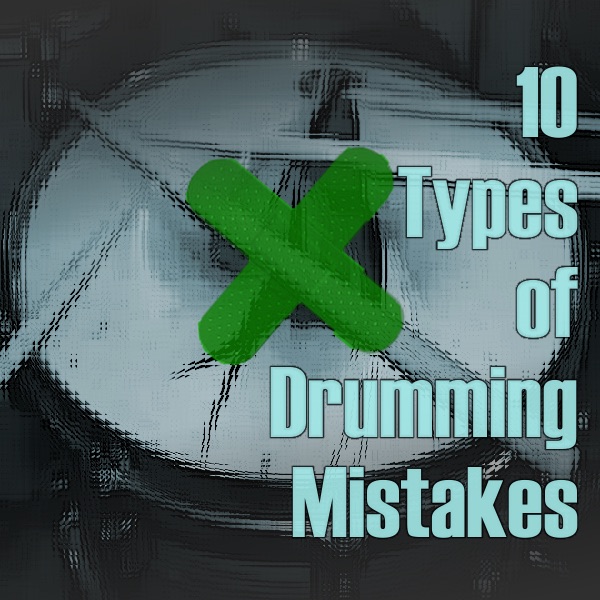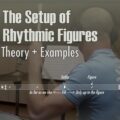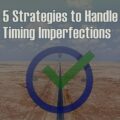I am impressed at the number of drummers that publish videos and content about this topic. It must be something we really care about! As usual I will try to give you a fresh approach and a new perspective on what mistakes in drumming are and how to avoid making them.
I think it’s important to start with a premise. Actually there are no mistakes: the only possible ‘mistake’ is being unmusical, is not making music, not expressing ourselves and not being authentic with our art. Our main purpose as musicians is not to sound ‘right’. It’s to make something happen, and create some beauty in the process.
If that doesn’t happen, we can sound as ‘good’ as we want, nobody is going to feel anything. That’s the only thing to avoid. On the other hand, if there’s music in what we do, everything else is irrelevant.
Making mistakes is the cause of way too much anxiety to most musicians. The reason is that we tend to irrationally link our worth as musicians to how perfect we sound. While quality is important, perfectionism is a trap.
Here is the only solution we need: it’s not the mistake that counts, it’s how we handle it. What I have learned from the greatest drummers (yes, they sometimes mess up too…) is to completely ignore the mistake, so that we don’t give power to it and we don’t fall in negative downward spirals, which are pretty dangerous during a performance.
Not uncommonly the mistake is not the note we missed, but actually what happens right after it: tension, self criticism, distraction, overthinking, fear of making more mistakes, fear of judgement and so on.
Even the most blatant mistake has very limited weight if from the next note we are back into the song and deeply focused on the music.

A very interesting aspect is that many drummers perceive as mistakes things which are not that important, and totally overlook crucial details that entail potentially more serious errors.
This is why I’ve decided to organize them and make a list to help you be aware of the things that have more weight and need to be kept into account.
We are going to use the powerful 4 parts model based on Physical, Logical, Emotional and Creative aspects of drumming (here is a detailed article about it) to address this subject and clearly distinguish between different things that may need to be optimized. Most ‘mistakes’ can easily be prevented if we just know and understand them.
We are going to see three physical mistakes, four conceptual, one emotional and two linked to creativity. These are not absolutes since many categories of mistakes may have features related to different parts. For each item I’m providing also a quick ‘fix’ to help you make progress in that particular area.
– Mistakes related to technique: this is the classic mistake, so much so that many drummers think it’s the only one that exists. Missing a note, stumbling, hesitating, not being consistent, hitting a rim instead of the drumhead, losing coordination, dropping a stick. Solution: do your homework especially on the fundamentals of drumming. Keep reviewing and reinforcing them on a regular basis.
– Rhythmic mistakes: these are mainly inaccuracies that happen when a certain figure we play is sloppy, and therefore our beats and fills that use it are not precise. It could be caused by not understanding the pattern (conceptual mistake), but most likely we haven’t repeated the correct motions for long enough. Solution: isolate the grouping that give you trouble and spend a couple of weeks on those.
– Timing mistakes: the most common ones are obviously rushing and dragging. But also playing fills at a slightly different tempo than the groove, playing inappropriately ahead or behind the beat, and playing the song at the wrong bpm. Solution: timing is very much related to motions, especially because as drummers we move a lot. Put simply, accurate, consistent movements equal flawless timing.
– Mistakes related to dynamics: these occur when we play at a volume that is unrelated to what’s happening musically around us. It has both a physical component, since it could very well be that we don’t have enough control to play with pertinent dynamics (if that’s the case, this will help), and also a conceptual aspect, since we may have the necessary technique yet have no idea what volume would be a good fit for a certain style or piece or section of a song. Solution: make lots of experience playing with good musicians which will invariably give you constructive feedback when your dynamics are not correct.
– Song form mistakes: here we have another mistake that can happen even if we are technically perfect. Things like: starting or stopping in the wrong place, missing a break, playing fills in random moments, not knowing where we are in the structure of the piece. Solution: studying music theory, developing concentration, learning to count, listening to and playing tons of music.
– Stylistic mistakes: these happen when we play stuff that is out of context. It’s a nuanced area because we definitely want to mix different influences in our style. However it’s unlikely that playing Funk with a Prog Rock approach will be pleasing to hear. This is often due to lack of musical knowledge, lack of awareness, sometimes distraction and even the need to please one’s ego (check out this article for an in-depth discussion about this component). Solution: be devoted to play for the music. Even if that entails having to listen and study a number of masterpieces in the style you are required to play.
– Mistakes linked to sound choice: this is also kind of a stylistic mistake, and is very common. What type of drums, cymbals, heads, sticks, tuning and sound are the best fit for the music you are playing? Of course we could try unusual things and be innovators in this area, yet what matters is that our choices are conscious and not completely unplanned. Solution: spend time experimenting with sound alternatives and combinations, and develop a personal aesthetic of sound.
– Feeling mistakes: let’s move on to errors connected to the emotional aspects of drumming. What’s the emotion underlying the song and even the lyrics of the song? Tension, peace, energy, joy, sadness: as drummers we need to embody the emotion that’s behind the piece we are playing and be congruent with it. Given that music is communication at a deep emotional level, messing up this one is among the most serious errors. Solution: feel the emotion of the song, dive into it, and then play that.
– Not listening: what’s the number one complaint other musicians have about drummers? Is that they don’t listen (ok, is that they rush, I know…). The key question is simple. How can we make music with others, interact and therefore create something together if we are not hearing what they are communicating to us? Solution: like in any conversation and shared experience, don’t just wait for your turn to talk and don’t think about what you are going to say next. Really care about what’s going on, focus on contribution, be present, focused, vigilant, responsive.
– Not being musical: as said above, this is the only true mistake, and in a sense it’s related to all of the other elements listed. The most crucial aspect of being musical, however, remains being creative. The distinction is the line drawn between being mere performers and being artists. Unless we are telling a story, saying something meaningful, expressing our uniqueness and reaching the listener, what we play is pointless. I find it astounding how overlooked this aspect is in the drumming community. Solution: connect to the same passion, love for music, intensity and excitement of creating something original, that made you want to grab a pair of sticks in the first place.
There are dozens of free resources in this Blog and I have only mentioned (and linked) a few. Feel free to use the internal search engine included in this page to look for the information you need.
One last point: mistakes are allowed and even useful when we practice and rehearse with our band, cause they mean we are pushing the envelope and stretching our comfort zone to reach new territories. When we are onstage or in the studio then quality tends to become more important than experimenting, and it’s up to us to decide how much risk we are willing to take on.
This list is important not because now we have to think about mistakes all the time, but because we can use it as a reference to show us what to study and what to work on in order to significantly improve our drumming skills.
Related resources:
‘Art & Musicianship’ – Altitude Drumming – Volume 10



















